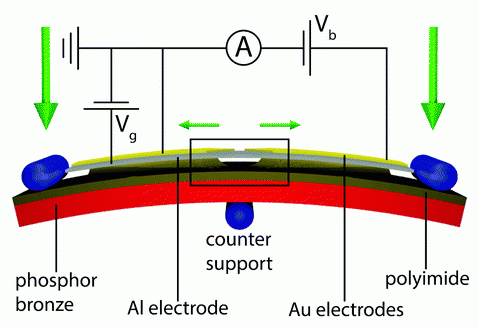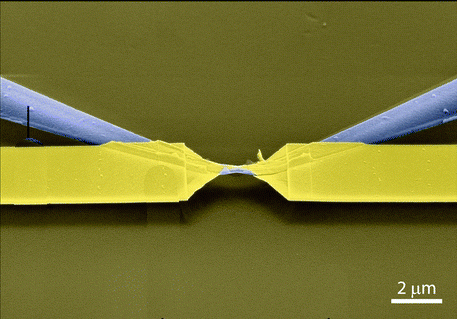A diode is a one-way street for electric currents. Researchers from the Kavli Institute of Nanoscience have now made one from a single molecule.
The first idea that a single molecule might one day be used as an electronic rectifier was launched more than forty years ago by the founders of the molecular electronics field. The first diode was measured in 2005, with a rectification ratio (ratio between opposite current directions) of 10. Many other attempts followed to increase this ratio, but this turned out to be a difficult endeavour.
In collaboration with chemists from the department of Chemical Engineering, Mickael Perrin and colleagues from the Kavli Institute for Nanoscience designed and measured a single-molecule diode that features rectification ratios higher than 600. In the Nanoscale journal of the Royal Society of Chemistry (April 6, 2016) they report on a molecule with a built-in rectifying mechanism, which is tuneable by a close-by located gate electrode.
The molecular junction is created by bending a nanometer-sized gold wire to its breaking point, thereby forming two atomically sharp metallic electrodes. The molecule is then trapped in between these. Measurements are then performed at 6 Kelvin by using liquid helium to cool down the samples. High rectification ratios up to more than 600 are found that can be tuned using the gate electrode.

The molecular junction is created by bending a nanometer-sized gold wire to its breaking point, thereby forming two atomically sharp metallic electrodes. The molecule is then trapped in between these. Measurements are then performed at 6 Kelvin by using liquid helium to cool down the samples. High rectification ratios up to more than 600 are found that can be tuned using the gate electrode.
The designed molecule consists of two aromatic halves that are connected by a saturated bridge that acts as barrier for charge transport. The rectifying behaviour relies on the built-in asymmetry: on one side fluorine atoms have been introduced that attract negative charges.
For one bias polarity this asymmetry allows charges to flow, while in the opposite direction it blocks them: a single-molecule one way street for electrical current is formed. This intrinsic mechanism is supported by the use of the gate electrode, ruling out alternative explanations involving the interaction with the electrodes.
At the end of the article, Perrin and colleagues fantasize about molecular devices with more than two sites in series that would allow the construction of new types of electronic components. Stay tuned for more.
Mickael Perrin, Herre van Zant et.al., A gate-tuneable single-molecule diode, Royal Society of Chemistry, April 6, 2016, DOI: 10.1039/C6NR00735J (paper version)



Comments are closed.